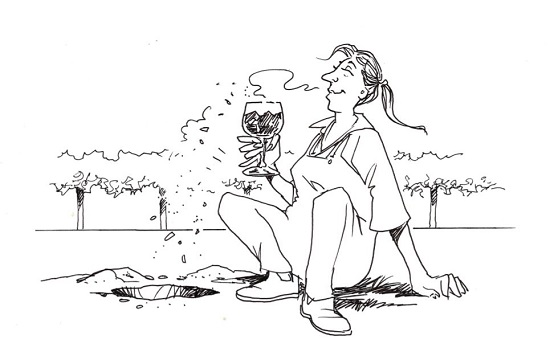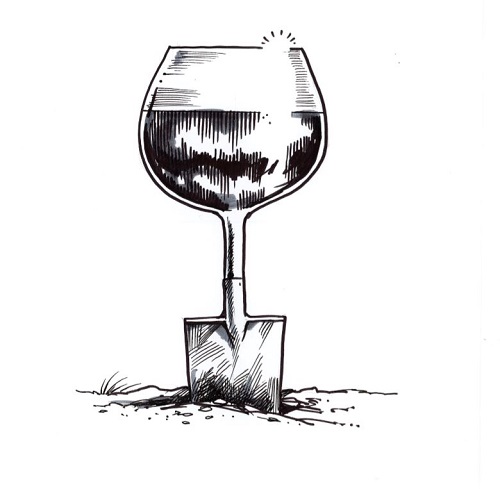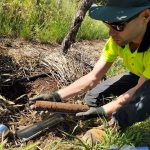My dear grower. We have been very close for a number of years now and I know in the depths of my profile that we will be together for a long time into the future. However, while everything might appear smooth on the surface, I am starting to see some cracks that are widening each year. Before it’s too late for us, there are some things that I need to share with you. To keep our wonderful partnership thriving, I have made a list of my grievances and some suggested changes you might like to consider for our future well-being.
MY STRUCTURE
Please understand that if you keep driving over the same tracks that all my air/pore spaces disappear, and I cannot provide the oxygen and water that soil organisms and vines need to prosper. The effects of compaction are especially detrimental when you drive on me after rain. There are a number of ways you could address this issue. Firstly, some periodic ripping, especially in the wheel tracks, will allow me to breathe again. I’m also a bit low on organic matter so you could add some manures or grow some mid-row cover crops or swards which would help give me some strength to cope with the unavoidable weight of tractors and machinery driving over me. It might be a good move to consider future machinery purchases and tyre choices to help with compaction as well. Don’t forget my undervine area too, as the constant application of drip-fed irrigation has caused me some issues there. These can be addressed with mulches both imported and grown undervine as well as the addition of some gypsum.
If you’d like to understand more about how your actions affect my structure, please refer to the AWRI’s viti-notes on soil strength, assessing soil structure and measuring soil porosity.
MY PH
When we first met, you measured my pHand I was slightly acidic. You said that it would be better if it was closer to neutral as that would allow the vines to have all the nutrients they needed available to them. So you added lime in my rip marks before planting the vines and broadcast some in the midrows to help get my pH where you wanted it. Unfortunately, I have become more acidic over time from your use of nitrogen fertilisers and irrigation water. To return my pH to where you’d like it you need to give me some lime to help deacidify and get me back to where I was when we first met.
To find out more about my pH, please read the AWRI’s viti-notes on measuring soil pH, liming and soil acidification.
CHEMICALS – TIME TO DETOX
I feel I need a detox after all the fungicides, herbicides, insecticides and fertilisers that have been sprayed on me. I have been able to deal with some of them; however, some things like copper are hard to process and can keep increasing each year. Our European friends are moving to restrict the average copper use to 4kg per hectare per year with a total of no more than 28kg/ha over a seven-year cycle. I’m pretty resilient and can cope with my fair share of chemicals in my system however it would be appreciated if you could cut down your chemical usage and choose softer, non-chemical options to make sure our vines and grapes are still going to be OK each year. Replacing undervine herbicides with mulch or growing undervine crops are good examples of what can be done.

MY NUTRITION
Each year our vines take a little more out of me as the grapes grow and mature. I know you have had to tighten the belt and have changed my diet in response to having less income in recent years. At a minimum, I really do need to have replaced what has been taken out each year. Maybe it could be my anniversary present after harvest? I know the vines have some specific nutritional requirements when they are growing and it makes me sad that I cannot provide this for them. You could find out what they need by testing their petioles at flowering to supplement any shortfalls. A list of standard nutritional requirements is available in the AWRI’s viti-note on petiole analysis.
MY MIDROW
This area is 80% of our vineyard. I know you like it when it’s mown and looks neat and tidy. I am so glad you decided a while ago to leave the rotary hoe in the shed and plant that permanent sward. It keeps me cool in summer and each year builds up my organic matter so I can hold more water and nutrients for our vines. I know you have been proactive in changing from clean cultivation to a sward but maybe there’s more you could do. Have you thought about leaving every tenth row or so to go to flower and seed to promote beneficial insects by providing food and habitat? This might mean we can use less chemicals. If it’s a bit too dry to do this, you could always add some micro sprays to irrigate those rows to keep them working effectively. This will then help to attract the lacewings, ladybugs and parasitoid wasps that help us combat the light brown apple moths, mealy bugs and scale which damage our vines.
MY VARIABILITY
I am complex as you know and made up of many different components. You have probably noticed this from those lovely aerial photos that we had taken a few years ago and how our vines respond to these differences with their growth. The vines and I would really appreciate it if you could please treat my different areas with management that is suited to each specific area. For example, where I am deep and have heavy soil with a high clay content, I don’t need as much water from irrigation as the shallow sections with the limestone subsoil. If you can lower vine vigour in the high vigour sections and promote increased vine growth in the low vigour sections, this will improve uniformity across the vineyard. This will have benefits for vine balance, more even ripening and more prudent use of resources. Once you have tried to even out the variability of the vines, it is a good idea to take another photo to observe the effects of the management changes.
SALINITY
I have seen the negative effects that other growers have experienced with their soils when soil salinity is not managed. Please be vigilant in looking for signs that the problem is arising and make sure that you test your irrigation water for salt content, use a leaching fraction when irrigating (if water is available) and monitor vines for symptoms. The AWRI has a viti-note on measuring soil salinity too.
Please don’t take this the wrong way but I feel like you have been taking me for granted for the last few years. If you think it’s necessary, we could always have some professional assistance from a soil surveyor or viticulturist to help to iron out these issues. I have also found lots of useful self-help links on the AWRI website for you to look at, including a really good fact sheet on assessing soil health.
I have penned this letter for the good of us both and in the interests of our future prosperity.
Regards
Your Soil,
By Tony Hoare, senior viticulturist, Australian Wine Research Institute
Illustrations by George Aldridge
This article was originally published in the Autumn 2019 issue of the Wine & Viticulture Journal. Click here to subscribe.
















